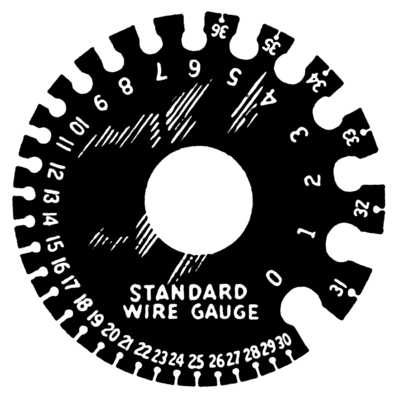Wire gauge: Difference between revisions
J.williams (talk | contribs) m 1 revision imported |
No edit summary |
||
| Line 1: | Line 1: | ||
[[Category:Done 2015- | [[Category:Done 2015-10-15]] | ||
[[File: | [[File:Wire_gauge_(PSF).png|400px|thumb|right|Figure 1. A diagram showing the different gauges of wire and their corresponding number based on its cross section.<ref>Wikimedia Commons. (October 3, 2015). ''Wire Gauge'' [Online]. Available: https://upload.wikimedia.org/wikipedia/commons/2/23/Wire_gauge_(PSF).png</ref>]] | ||
<onlyinclude>'''Wire gauge''' is the measure of how large of a cross section a [[wire]] has. Knowing the gauge is important because it tells | <onlyinclude>'''Wire gauge''' is the measure of how large of a cross section a [[wire]] has. Knowing the gauge is important because it tells you how much [[current]] a wire can carry without being damaged - this quantity is called [[ampacity]].</onlyinclude> | ||
==American Wire Gauge System== | |||
The American Wire Gauge system | The American Wire Gauge system or AWG allows for standard wire sizes - determined by cross sectional area - to be identified and assigns them an AWG number. A lower gauge wire has a larger diameter and thus is able to carry higher currents. There are a total of 40 different gauge sizes with cross sectional areas ranging from 0.013 mm<sup>2</sup> to 107.22 mm<sup>2</sup> with their diameters changing incrementally between each gauge number. | ||
==Wire Gauge Values== | |||
<html> | <html> | ||
<style> | <style> | ||
| Line 267: | Line 268: | ||
</table> | </table> | ||
The figures above are taken from ''Table 310.15(B)(16) in the 2014 National Electrical Code (USA)'' and assume a temperature rating of 90°C<ref>"2014 National Electrical Code" Table 310.15(B)(16)</ref> | The figures above are taken from ''Table 310.15(B)(16) in the 2014 National Electrical Code (USA)'' and assume a temperature rating of 90°C.<ref>"2014 National Electrical Code" Table 310.15(B)(16)</ref> Also, Table 3.1 on page 69 in ''Introduction to Electricity'' was used as a template and reference.<ref name=R1>"Introduction to electricity" Pearson: Robert T. Paynter, B.J Toby Boydell</ref> | ||
For a more complete list, please see Dr. Rowlett's [http://www.unc.edu/~rowlett/units/scales/wiregauge.html unit page]. | For a more complete list, please see Dr. Rowlett's [http://www.unc.edu/~rowlett/units/scales/wiregauge.html unit page]. | ||
| Line 273: | Line 274: | ||
{{reflist}} | {{reflist}} | ||
[[Category:Uploaded]] | [[Category:Uploaded]] | ||
[[category: Mark edit]] | |||
Revision as of 04:55, 4 October 2015

Wire gauge is the measure of how large of a cross section a wire has. Knowing the gauge is important because it tells you how much current a wire can carry without being damaged - this quantity is called ampacity.
American Wire Gauge System
The American Wire Gauge system or AWG allows for standard wire sizes - determined by cross sectional area - to be identified and assigns them an AWG number. A lower gauge wire has a larger diameter and thus is able to carry higher currents. There are a total of 40 different gauge sizes with cross sectional areas ranging from 0.013 mm2 to 107.22 mm2 with their diameters changing incrementally between each gauge number.
Wire Gauge Values
| AWG number | Cross sectional area (mm2) | Ohms/km (/km) | Ampacity (A) | Usage example |
|---|---|---|---|---|
| 18 | 0.82 | 20.95 | 14 | Low voltage lighting |
| 16 | 1.31 | 13.18 | 18 | Extension cords |
| 14 | 2.08 | 8.28 | 25 | Lighting fixtures |
| 12 | 3.31 | 5.21 | 30 | Kitchen appliances |
| 10 | 5.26 | 3.28 | 40 | Electric dryers |
| 8 | 8.37 | 2.06 | 55 | Electric ovens |
| 6 | 13.30 | 1.30 | 75 | Large electric heaters |
| 4 | 21.15 | 0.81 | 85 | Large furnaces |
| 3 | 26.67 | 0.65 | 115 | Large commercial wiring |
| 2 | 33.63 | 0.51 | 130 | Car battery cable |
| 1 | 42.41 | 0.41 | 145 | Power distribution |
| 1/0 | 53.47 | 0.32 | 170 | Power distribution |
| 2/0 | 67.43 | 0.26 | 195 | Power distribution |
| 3/0 | 85.03 | 0.20 | 225 | Power distribution |
| 4/0 | 107.22 | 0.16 | 260 | Power distribution |
| 250 | 126.68 | 0.13 | 290 | Power distribution |
| 350 | 177.35 | 0.10 | 350 | Power distribution |
| 400 | 202.68 | 0.08 | 380 | Power distribution |
The figures above are taken from Table 310.15(B)(16) in the 2014 National Electrical Code (USA) and assume a temperature rating of 90°C.[2] Also, Table 3.1 on page 69 in Introduction to Electricity was used as a template and reference.[3]
For a more complete list, please see Dr. Rowlett's unit page.
References
- ↑ Wikimedia Commons. (October 3, 2015). Wire Gauge [Online]. Available: https://upload.wikimedia.org/wikipedia/commons/2/23/Wire_gauge_(PSF).png
- ↑ "2014 National Electrical Code" Table 310.15(B)(16)
- ↑ "Introduction to electricity" Pearson: Robert T. Paynter, B.J Toby Boydell

